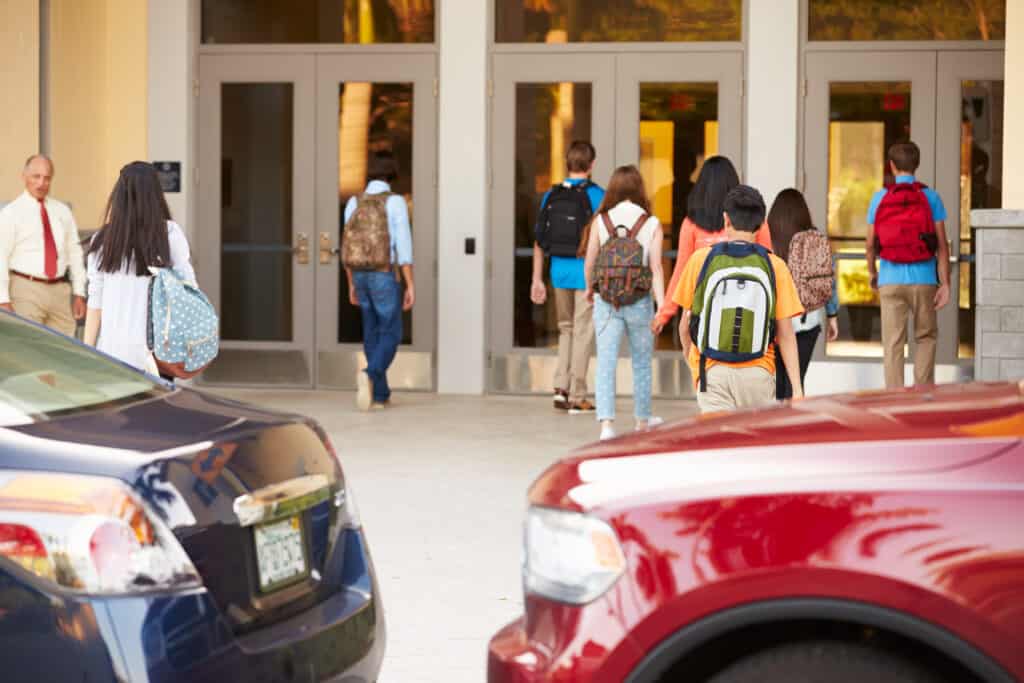School safety and security audits play a crucial role in ensuring that educational institutions provide a secure environment for their students and staff. In Texas, these comprehensive assessments aim to evaluate the effectiveness of existing safety measures and identify areas for improvement. By understanding the current state of a school’s safety procedures and policies, administrators can develop actionable plans to create a safer learning atmosphere for everyone.
During a Texas School Safety and Security Audit, various aspects of a school’s current safety and security conditions are examined. These evaluations should be conducted during normal school or facility operations, when students and staff are present, to accurately assess the situations they face daily. Some key factors assessed include access control, security equipment, emergency plans, and staff training.
Through the process of conducting a safety and security audit, schools and districts receive valuable insights and recommendations. This information empowers them to make informed decisions about resources and strategies, ultimately enhancing the overall safety of their educational environments. With the implementation of improved safety measures, Texas schools can continue to foster a sense of security and well-being among their students and staff members.
Texas Education Code 37.108
Under Texas Education Code 37.108, all Texas schools are mandated to conduct a safety and security audit every three years. The purpose of these audits is to assess the district’s safety and security measures, identify potential risks, and implement appropriate policies to maintain a safe environment for students, faculty, and staff.
The audit process is comprehensive, covering a wide range of safety and security factors, including:
- Emergency operation plans
- Building security systems
- Visitor management procedures
- Communication protocols
- Crisis response planning
The Texas School Safety Center (TxSSC), a state agency that supports school districts in creating and maintaining safe and secure learning environments, oversees the audit process. The TxSSC provides guidelines, resources, and training to help schools conduct effective audits and develop strategies to address identified risk factors.
In addition to conducting audits, Texas Education Code 37.108 also mandates that school districts report the results of their audits to the TxSSC. This enables the center to track statewide trends, analyze data, and provide recommendations for best practices and policy improvements.
Furthermore, each school district must maintain a multi-hazard emergency operations plan, which is regularly reviewed and updated according to audit findings. These plans address various potential threats, such as:
- Natural disasters (e.g., hurricanes, tornadoes, floods)
- Human-made disasters (e.g., hazardous material releases, nuclear accidents)
- Technological disruptions (e.g., power outages, cybersecurity incidents)
- Criminal acts and acts of violence (e.g., shootings, bomb threats, terrorism)
By adhering to the requirements of the Texas Education Code 37.108, schools in Texas demonstrate their commitment to protecting the well-being of their students and staff and creating a supportive learning environment.
Safety and Security Audits
Safety and security audits are crucial for ensuring the well-being of students and staff in educational institutions. These audits assess the current safety and security conditions in schools to protect against potential threats and risks. By conducting regular audits, schools can identify areas of improvement, develop action plans, and maintain compliance with state and federal regulations.
To achieve optimal results, it is advisable that safety and security audits are carried out during normal school hours when students and staff are present. This allows for an accurate evaluation of the school’s practices and procedures in a realistic setting. In Texas, the Texas School Safety Center provides guidelines and resources to assist schools in effectively conducting their audits.
A comprehensive security audit typically includes a thorough assessment of various aspects such as access control, surveillance systems, communication processes, and emergency response planning. Furthermore, a school safety audit evaluates the overall environment both inside and outside the school premises, considering factors like lighting, signage, and campus landscaping. Collaboration among school administrators, local law enforcement, and relevant stakeholders is essential in obtaining an in-depth understanding of the school’s safety and security environment.
In addition to identifying vulnerabilities, a safety and security audit helps in establishing a strong foundation for continuous improvement. Schools should develop and implement action plans based on the findings of the audit, prioritizing the most pressing issues. Periodic follow-up audits ensure that these action plans are effectively executed and that the school remains in compliance with current safety requirements.
Undoubtedly, conducting safety and security audits is a vital aspect of maintaining a secure and supportive learning environment. By consistently evaluating and refining their safety and security measures, schools can provide a safe and conducive atmosphere for students and staff alike.
Texas School Safety Center
The Texas School Safety Center (TxSSC) is a significant entity focused on providing a safe and secure learning environment for children across the state. Established by the Texas legislature in 1999, the TxSSC is dedicated to training, technical assistance, and research in the area of school safety and security.
One of the key responsibilities of the TxSSC includes the development and implementation of school safety and security audits. These audits serve as a comprehensive assessment of the safety and security measures implemented across various educational facilities. By evaluating factors such as physical security, emergency preparedness, and policy and procedural protocols, the TxSSC plays a crucial role in ensuring a secure educational environment for students and staff.
In addition to conducting audits, the TxSSC also offers a wide range of training services for school staff and administrators. They provide workshops, seminars, and online courses on a variety of topics, such as emergency response, cyber security, and mental health support. These training programs are aimed at equipping school personnel with the necessary knowledge and skills to implement effective safety and security measures.
Overall, the Texas School Safety Center serves as a valuable resource for schools throughout the state. With its commitment to providing the necessary tools, resources, and training, the TxSSC plays a crucial role in fostering safe learning environments for students, educators, and communities in Texas.
Audit Implementation and Procedures

The Texas School Safety and Security Audits follow a well-structured cycle and are carried out by a team of professionals who adhere to strict procedures. Each district is required to undergo a security audit every three years, ensuring that safety and security measures are continuously evaluated and improved upon.
At the beginning of each audit cycle, a designated audit team is assembled. This team typically consists of knowledgeable members who possess expertise in areas such as law enforcement, security, and threat assessment, as well as individuals familiar with the unique needs of educational institutions. These team members not only have relevant experiences in their respective fields, but are also skilled in approaching matters with a neutral and clear perspective.
The audit team proceeds by conducting a comprehensive review of the safety and security measures currently in place at each school. This process involves:
- Assessing the physical security of buildings and grounds
- Evaluating emergency preparedness and communication strategies
- Reviewing policies and procedures related to discipline and crisis intervention
- Monitoring staff training and student awareness about safety and security issues
The team uses a variety of tools and techniques to gather relevant data, including site visits, in-person interviews, and documentation reviews. Careful attention is given to balancing the need for safety while maintaining a welcoming and accessible learning environment for students.
Once the audit is complete, the team prepares a detailed report that highlights areas of strength and opportunities for improvement. This report is shared with school administrators and the wider community, ensuring transparency and fostering collaboration to address any identified gaps in the existing safety and security measures.
District Audit Reporting Tool (DARTOOL)
The District Audit Reporting Tool, or DARTOOL, is an essential component in Texas’ efforts to ensure the safety and security of schools. This tool serves as a comprehensive platform for school districts to report their security audit findings and track progress on implementing improvements.
DARTOOL enables districts to easily submit their audit reports and share crucial school safety data with state authorities. This streamlined process allows for better coordination and sharing of best practices among districts so that they can benefit from each other’s knowledge and experience.
The platform is user-friendly, ensuring that district administrators can navigate the system easily and enter relevant data without complications. It also offers a high degree of security, safeguarding sensitive information at all times. Some key features of DARTOOL include:
- Centralized data storage and reporting, making it simple and efficient for districts to submit their security audits
- Customizable templates and tools that help districts tailor their audit reports to best fit their unique situations
- A secure encryption system that ensures sensitive data remains protected while in transit and at rest
By employing DARTOOL, Texas schools are better equipped to address safety and security concerns and implement proactive measures to ensure the wellbeing of students, staff, and communities. The District Audit Reporting Tool serves as a foundation for continuous improvement in the crucial area of school safety, demonstrating its value as an instrument for positive change.
Safety and Security Committee
In Texas, the Safety and Security Committee plays a crucial role in ensuring the well-being of students, staff, and visitors in district facilities. The committee comprises district personnel, community stakeholders, and experts in safety and security matters. Their primary focus is to provide guidance and oversight in the development, implementation, and review of safety and security policies and measures within school districts.
The Safety and Security Committee conducts regular assessments of district facilities to identify potential vulnerabilities and opportunities to enhance safety. These assessments include reviewing the physical security of buildings, evaluating access control systems, and analyzing surveillance capabilities. The committee also considers the effectiveness of safety procedures, such as emergency drills and staff trainings.
The involvement of district personnel is critical to the success of the committee. They are responsible for implementing the recommended safety and security measures and ensuring that all staff and students adhere to established policies. District personnel also engage in ongoing professional development to stay informed about best practices for school safety and security.
Collaboration is key for the Safety and Security Committee, as they work with local law enforcement, emergency responders, and other agencies to establish a coordinated response in the event of an incident. By fostering these relationships, the committee facilitates communication and information sharing, promoting greater overall safety for the school community.
In summary, the Safety and Security Committee in Texas is a vital component in the ongoing efforts to maintain secure and protective environments for students and staff in district facilities. With their expertise, dedication, and collaboration with district personnel and external partners, they work tirelessly to ensure the well-being of the school community.
District Emergency Operations Plan
A District Emergency Operations Plan (EOP) is crucial in ensuring the safety and security of schools in Texas. This comprehensive plan serves as a guideline for addressing various hazards and emergencies that may occur and outlines the responsibilities of different authorities involved in the school district.
The basic plan consists of multiple layers, including district-wide policies, campus-specific protocols, and facility management strategies. By considering all these factors, the EOP aims to minimize the impact of emergencies and facilitate an efficient response and recovery process.
One essential component of the District Emergency Operations Plan is identifying potential risks and developing appropriate response plans. These risks can be natural, like hurricanes, floods, and wildfires, or human-caused, such as threats, violence, and technological accidents. Through a thorough risk assessment, districts can prioritize hazards and allocate resources effectively.
To support the implementation of the EOP, regular training and exercises should be conducted for all school staff, including administrators, teachers, and support personnel. This training ensures that staff members are well-prepared to handle emergency situations and are familiar with the procedures outlined in the plan. Collaborative training with local first responders and other partners will also enhance the overall effectiveness of the emergency response.
In addition, communication plays a vital role in the District Emergency Operations Plan. A well-designed communication plan should be established to facilitate information sharing among stakeholders, such as school district officials, emergency management agencies, and parents. In times of crisis, clear and accurate communication is essential to maintain order and ensure the safety of students and staff.
Maintaining and updating the District Emergency Operations Plan is a continuous process. Regular reviews and audits should be conducted to identify any gaps, weaknesses, or changes in the school environment. Feedback from staff, students, and other stakeholders can be used to improve the plan and ensure it remains relevant, effective, and aligned with current best practices in school safety and security.
Conducting Facility Audits
Conducting facility audits is a crucial aspect of ensuring school safety and security in Texas. An effective audit evaluates the school’s current safety and security measures, systematically identifying vulnerabilities, hazards, and potential threats. The process typically involves conducting surveys and assessments during regular school operations when students and staff are present, allowing for an accurate representation of daily conditions.
A comprehensive facility audit should focus on both internal and external factors. This includes evaluating the physical structure of the school, access control measures, and communication systems. The audit should also consider the policies in place to handle safety concerns, including staff training, emergency preparedness, and student incident reporting.
One approach to conducting the facility audit is to assemble a multidisciplinary team comprising representatives from the school administration, faculty, local law enforcement, and other relevant stakeholders. Their collective knowledge and insights help identify potential gaps in existing safety and security protocols and suggest practical, cost-effective solutions to address these concerns.
When evaluating a school’s vulnerabilities, it is essential to consider both natural and human-made hazards. Natural hazards may include severe weather events, fires, or flooding, while human-made threats encompass acts of violence, accidents, or vandalism. Organizing the identified vulnerabilities into categories can make it easier to prioritize and address them accordingly.
In conclusion, a robust facility audit serves as an essential step toward ensuring a safe and secure school environment in Texas. Incorporating relevant stakeholder perspectives, identifying potential vulnerabilities, and considering both internal and external factors can lead to improved safety measures and a more secure school community.
Audit Results Reporting
Upon completion of a school safety and security audit in Texas, the audit results must be meticulously documented and reported to the relevant authorities. Crafting a comprehensive audit report helps in highlighting the strengths and weaknesses of the existing safety and security measures in place. It also lays out a framework for improvement in the future.
The audit report serves as an invaluable tool that not only benefits the school administration but also provides a sense of assurance to parents and the community at large. It is imperative that the contents of the report remain accurate and detailed. The report should include findings, recommendations, and any applicable plans for action.
When it comes to reporting audit results, the superintendent plays a critical role. They are responsible for presenting the audit findings and recommendations to the board of trustees in a timely and efficient manner. Since the board of trustees holds the authority to allocate resources and make final decisions in the interest of school safety and security, their involvement in understanding and acting upon the audit results is crucial.
In some instances, reporting audit results might necessitate a closed session between the superintendent and the board of trustees. These closed sessions occur when privacy concerns or sensitive security information need to be discussed. The goal of such meetings is to ensure that the school’s safety and security weaknesses are not unintentionally exposed to potential threats. It also allows the board to weigh the recommendations carefully before adopting new policies.
To further bolster safety and security in Texas schools, conducting school safety and security audits during normal school or facility operations is highly recommended. This approach enables auditors to assess the actual conditions and effectiveness of the school’s safety and security measures in real-time.
In conclusion, careful reporting of audit results to the superintendent and the board of trustees is a significant step in identifying areas of improvement and ensuring the safety of the entire school community. Utilizing audit findings effectively helps create a secure learning environment for students, staff, and stakeholders.
Conclusion
Conducting School Safety and Security Audits in Texas is a crucial step towards ensuring a safe and secure learning environment for students and staff. By evaluating the current state of school safety measures and taking corrective actions, administrators can effectively enhance the well-being of their educational communities.
One of the key aspects of these audits is that they should be carried out during normal school operations, capturing the most accurate representation of the school’s safety and security conditions. This approach enables stakeholders to identify areas that require improvements and prioritize necessary changes.
Moreover, the findings from these audits serve as a valuable source of information for decision-makers, who can allocate resources effectively based on the identified needs. Additionally, the audit process facilitates the involvement of various stakeholders such as students, faculty, and law enforcement agencies, fostering collaboration and ownership in addressing safety concerns.
In the end, Texas School Safety and Security Audits have the potential to strengthen the overall safety of educational facilities. By implementing these measures properly and continuously reviewing their progress, Texas schools can create an environment that guarantees the well-being of their communities and fosters positive learning experiences.
Frequently Asked Questions
What are the key components of a Texas school safety audit?
A Texas school safety audit consists of several key components, including assessing the physical security of school buildings, evaluating policies and procedures, and ensuring the effectiveness of emergency preparedness plans. This process helps to identify potential vulnerabilities and provide recommendations for improvement to enhance the overall safety and security of the school environment.
How does an intruder detection audit contribute to the overall security?
An intruder detection audit plays a crucial role in the overall security of a school by identifying potential entry points and vulnerabilities that may be exploited by unauthorized individuals. By conducting regular audits, schools can implement appropriate measures, such as updating access control systems or reinforcing doors and windows, to enhance their security against potential threats.
What steps are involved in conducting a school safety audit?
Conducting a school safety audit involves several steps, including gathering relevant data, conducting a comprehensive evaluation of facilities, reviewing policies and procedures, and developing recommendations for improvement. Audits should be conducted during normal school operations, ensuring that they provide an accurate reflection of the safety and security conditions during regular school activities, as suggested by the TxSSC.
How can schools effectively implement the recommendations from safety audit reports?
To effectively implement recommendations from safety audit reports, schools should work collaboratively with stakeholders such as staff, students, and parents. A school should establish a prioritized action plan, designate responsible parties for implementation, and set realistic timelines for completion. Tracking progress and conducting regular follow-up assessments will help ensure that improvements are sustained and effective.
What are important aspects to include in a school safety audit checklist?
A comprehensive school safety audit checklist should include aspects such as facility access control, emergency preparedness, safety and security policies, communication procedures, and staff training. Other essential elements to consider include monitoring of school grounds, lighting, signage, and the presence of security equipment such as cameras and alarms.
How does the TEA audit checklist contribute to improving school safety?
The Texas Education Agency (TEA) audit checklist provides a standardized framework for evaluating school safety and security measures. By following this checklist, schools can ensure they are addressing critical safety issues and maintaining a consistent approach to security improvement. The TEA audit checklist assists schools in meeting legal requirements and providing a safe learning environment for all students.
Is your school as safe as it could be? Risk Strategy Group can help you find out. Our expert consultants are all certified by the Texas School Safety and Security Consultant Registry and are skilled in conducting comprehensive safety and security audits.
We can identify potential vulnerabilities, offer actionable recommendations, and help you implement robust security measures. Don’t wait for a crisis to reveal the gaps in your school’s safety plan. Contact Risk Strategy Group today and let’s ensure your school is a safe learning environment for everyone.








